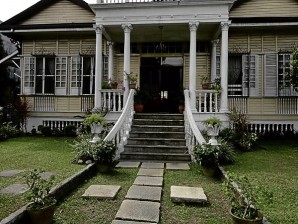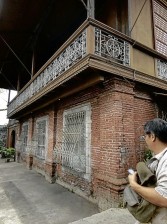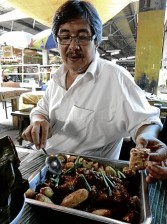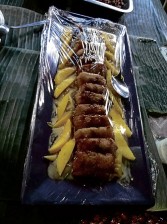Keepers of Iloilo heritage

THE CONCEPCION chalet in Jaro district is an American-influenced structure, restored by Antonio Concepcion Pastelero. PHOTO BY AGNES PRIETO
An architect, a businesswoman, a banker and a chef share a passion of bringing Iloilo’s past to the present.
Eugene Jamerlan, the architect, captures pieces of history in old buildings, in food, in remembering events and in art, and gives them relevance. Lea Celis, the businesswoman, is a mover of the Graciano Lopez Jaena Foundation, which keeps alive the spirit of nationalism inspired by the hero.
Luth Camina, the banker, has restored her family house, Camina Balay na Bato, turning it into a living museum. Chef Tibong Jardeleza revives old family recipes and well-guarded secrets, and, with much flair, transforms them into nouvelle cuisine.
They are the heritage keepers of Iloilo, a storied place dubbed “La Reina Ciudad del Sur” (Queen City of the South) which reigned during the era of prosperity and stability after the Philippine American War, from the 19th century to the early 20th century.
Sugar barons built resplendent mansions, fruits of the haciendas teeming with the sweet cane. The weaving industry flourished. A sumptuous lifestyle evolved (the oldest golf course in the Philippines is in Santa Barbara, Iloilo). The Kahirup Balls were the height of social scenes even up to the late ’60s.
Secret recipes

CASA MARIQUIT and houses such as these were built to house generations in stability and prosperity. PHOTO BY AGNES PRIETO
The magnificent Art Deco buildings along Calle Real, the city’s main street and prime commercial avenue of the country at that time, were mostly designed by Ilonggos. A movement has evolved to bring back the old glory days of these treasures.
The journey to the past starts with lunch by Chef Tibong at the heart of the old market. His ancestors were meat suppliers to the friars and many family generations have kept the secret recipes of sausages, hams and bacon that the friars loved.
On the slabs of cement, where produce is sold, a veritable feast on banana leaves beckons: duck “hamonado,” salmon “adobado,” market salad, “ginataang gulay (vegetable cooked in coconut),” “inihaw na baboy (grilled pork)” and “chicken binakol,” all topped off by “suman” with a twist— caramelized with a tangy mango/jackfruit sauce.
Coffee is served Iloilo Central Market-style—to-go in used cans of milk.
Everything on the tour carries a highlight from the past.
Javellana house
The woman of the 200-year-old Javellana house was Mariquit Javellana Lopez, who would elope with Fernando Lopez, a future statesman whose brother would spawn one of the great fortunes of the country.
Preserved by her grandson, Robert Lopez Puckett, this well-appointed house, though not as grand as other mansions in Jaro (formerly the exclusive enclave), has a wraparound balcony of finely crafted wrought iron, a prayer room or “oratoryo,” and a ground floor entrance for a “caruaje” to park right in front of the polished stairway.
Houses such as these, according to historian T. Maximo Kalaw, were built to house generations in stability and prosperity.
Business was on the ground floor where a huge cement vault was found; the owner was a moneylender. The luxurious appointments were on the second floor where they lived and entertained, hobnobbing with politicians and beauties.
Among the treasured photos are shots with Henry Kissinger, King Bhumibol of Thailand and Dewi Sukarno.
Balay na Bato
Camina Balay na Bato on Arevalo Street evolved from a “camarin” house, an expanded and fortified “bahay kubo.” Prosperous weaver Fernando Avanceña in La Villa Rica de Arevalo, seat of the southern administration of the Spanish government, built the house on 24 “trozos” or wooden pillars strengthened by lime and plaster in 1860.

CHEF Tibong Jardeleza revives old family recipes and well-guarded secrets, and transforms them into new cuisine. PHOTO BY AGNES PRIETO
The ground floor houses the weaving looms in the “talyer” or workshop, while the family relaxes and socializes on the second floor, secured by massive wooden doors (necessary attachments in the olden days as this was the time of the pirates’ attacks).
Today, descendant Luth Camina has transformed it into a living museum, the “almacen” or warehouse now an artisan’s shop selling local crafts, including handwoven textile. Old-style “merienda” from gracious times is served, complete with “panara” (meatless poor man’s “empanada”), “kutsinta” and authentic chocolate made with the “batirol” highlighted by Camina’s stories.
Jardin Elena
The Lopez Jaena Foundation preserves the nationalistic spirit initiated by the hero. A park, Jardin Elena, on the lot where Ilonggo hero Graciano Lopez Jaena was born, now flourishes, giving shade.
On July 2, a mass wedding was officiated by Mayor Jed Mabilog at the park. A library in honor of the hero will also be established at the old provincial capitol.
“Mightier than the Sword” celebrates the great intellectual’s life, written by Demy Sonza. “The Ghost of Fray Botod” is a popularized, fiction series about the revolution for young people by Ignacio
LLlenberge; along with rhymed oratory or Binalaybay contests—all are foundation projects.
Concepcion Chalet
The Concepcion Chalet in Jaro is an American-influenced home, now with en suite bathrooms and electricity. The “volades” or deep eaves, the “barandillas” of old are still part of it.
Restored by a grandson, Antonio Concepcion Pastelero, it is a single-story home built with a modern functional layout.
Eugene lovingly tracks the past and the lifestyles that evolved in delicate traceries of “ventanillas,” sliding panels for natural ventilation of old houses; the use of the “garapon” or glass containers for merienda food (instead of plastic) intertwining architectural details, old customs with personal stories and historical data in a rich tapestry of remembrances. The afternoon ends with a gracious flourish.
The value of memories is immeasurable. Sustained by these heritage keepers, mortar and stone, rare delicacies, tradition and custom, heroic deeds become more precious for they make tangible the spirit of times gone by making them part of the present, to inspire, to make glad and to expand the awareness of this generation beyond.
For those interested to do a tour, call Eugene Jamerlan, 09185064776, Chef Tibong, 09176206900, or Luth Camina, 09177222359.















